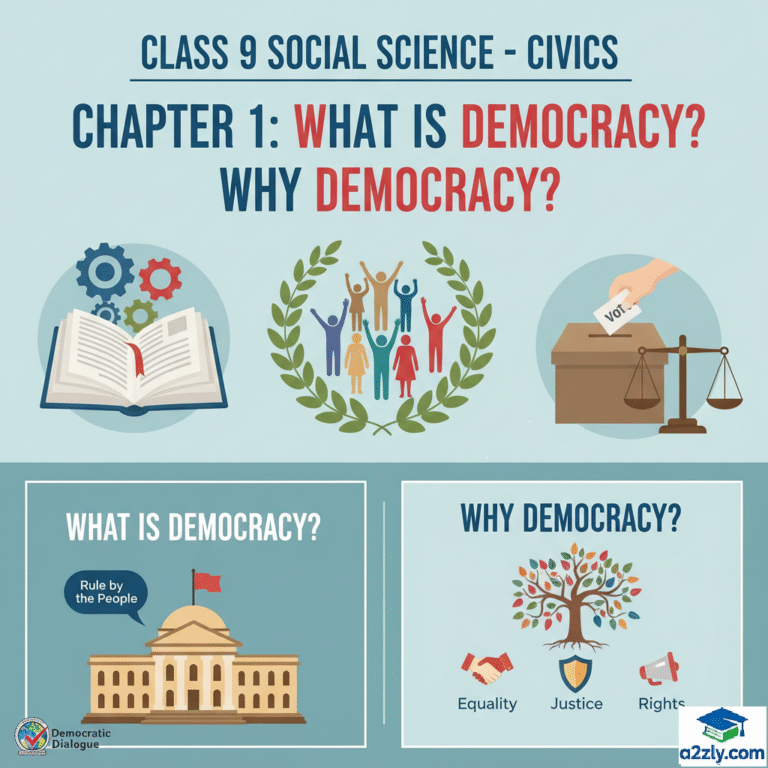Democracy is not just a system of government—it’s a way of life that empowers people to participate in decision-making. In Class 9 Social Science Civics Chapter 1 – What is Democracy Why Democracy, students explore what makes democracy the most preferred form of government. This chapter from the NCERT textbook explains the meaning, features, and significance of democracy in simple terms, helping young learners understand how people’s voices shape governance and ensure equality, freedom, and justice for all.
TABLE OF CONTENTS
1. Short Notes for Ch 1: What is Democracy Why Democracy
- Democracy Definition: Rule by the people, derived from Greek ‘demos’ (people) and ‘kratia’ (rule). Involves government of the people, by the people, for the people (Abraham Lincoln).
- Key Features: Participation of citizens, free/fair elections, rule of law, protection of rights, majority rule with minority rights.
- Why Define Democracy?: Needed to distinguish from non-democratic systems. Words evolve, so meaning clarified through use and debate.
- Evolution of Meaning: Originally computing devices; now multifaceted (writing, music). Democracy’s meaning shifts with context beyond Greek origin.
- Democratic vs Non-Democratic: Democratic: Elections, citizen involvement (e.g., India). Non-democratic: Dictatorship, no elections (e.g., North Korea).
- Global Spread: Most common government today, expanding (e.g., South Africa post-1994). Raises question: Why preferred?
- Debate on Definition: No shortcut; requires thinking. Lincoln’s view beautiful but needs practical understanding.
- Classroom Discussion: Lyngdoh Madam encourages students to define terms like pen/rain, showing democracy needs active interpretation.
2. Multiple Choice Questions (MCQs)
- Democracy means: A) Rule by king B) Rule by people C) Rule by army D) Rule by elite
- Greek origin of democracy: A) Demos and kratia B) Rex and regna C) Polis and archon D) Theo and kratos
- Abraham Lincoln’s definition: A) Of, by, for the people B) For, with, by the king C) By, with, for the elite D) Of, with, by the army
- Why define democracy? A) For fun B) To distinguish from others C) To confuse students D) No need
- Democratic feature: A) No elections B) Free elections C) Dictator rule D) No rights
- Non-democratic example: A) India B) South Africa C) North Korea D) USA
- Democracy’s global spread: A) Declining B) Expanding C) Static D) Rare
- Word meaning changes: A) Never B) With time/context C) Only in Greek D) Fixed
- Lyngdoh Madam’s approach: A) Give ready answers B) Encourage thinking C) Avoid discussion D) Use shortcuts
- Democracy better why? A) No reason B) Participation, rights C) Dictatorship D) Less freedom
Answer Key: 1-B, 2-A, 3-A, 4-B, 5-B, 6-C, 7-B, 8-B, 9-B, 10-B
3. Very Short Answer Type Questions (VSAQs)
- What is democracy? Answer: Rule by the people.
- Greek roots? Answer: Demos (people), kratia (rule).
- Lincoln’s definition? Answer: Of, by, for the people.
- Why define it? Answer: To distinguish from other systems.
- Democratic feature? Answer: Free and fair elections.
- Non-democratic example? Answer: North Korea.
- Global trend? Answer: Expanding.
- Word evolution? Answer: Changes with time.
- Lyngdoh’s method? Answer: Encourages thinking.
- Better than others? Answer: Due to participation.
4. Short Answer Type Questions (SAQs)
- Explain democracy’s origin. Answer: Comes from Greek ‘demos’ (people) and ‘kratia’ (rule), meaning rule by people. Shows early idea of citizen involvement.
- Why is definition needed? Answer: Helps distinguish democracy from non-democratic forms. Clarifies meaning as usage varies.
- Features of democracy? Answer: Includes elections, citizen participation, rule of law, and rights protection. Ensures voice of people.
- Non-democratic traits? Answer: Lack of elections, dictator rule, no citizen rights. Example: North Korea.
- Lincoln’s view? Answer: Defines as government of, by, for the people. Reflects ideal participation.
- Word meaning shift? Answer: Like computers from calculating to multimedia, democracy’s meaning evolves with use.
- Global spread reason? Answer: Offers participation and rights, seen as better than autocracy. Example: South Africa.
- Lyngdoh’s teaching? Answer: Encourages students to think, not accept blindly. Uses examples like pen/rain.
- Debate importance? Answer: Helps refine understanding. Avoids accepting famous quotes without thought.
- Why preferred? Answer: Gives people voice, protects rights. Contrasts with oppressive systems.
5. Long Answer Type Questions (LAQs)
- What is democracy? Explain its features. Answer: Democracy means rule by the people, originating from Greek ‘demos’ and ‘kratia’. Its features include free and fair elections, citizen participation, rule of law, and protection of rights for all, including minorities. This ensures governance reflects people’s will, unlike dictatorships, and is why countries like India thrive with it.
- Why do we need to define democracy? Answer: Defining democracy is crucial as people use the term differently, from true participation to mere labels. It helps distinguish it from non-democratic systems like North Korea, where no elections occur. Lyngdoh Madam’s class shows thinking through examples like pen or rain aids clarity, avoiding blind acceptance of famous quotes like Lincoln’s.
- Compare democratic and non-democratic governments. Answer: Democratic governments, like India, hold elections and involve citizens, ensuring rights and law. Non-democratic ones, like North Korea, rely on dictators, suppress votes, and ignore rights. The difference lies in participation, making democracy preferable for freedom and accountability.
- Discuss the evolution of the word democracy. Answer: The word democracy comes from Greek, meaning rule by people, but its meaning has evolved. Like computers shifting from calculating to multimedia, democracy now includes broader participation and rights beyond its origin. This shift reflects changing governance needs, debated in class by Lyngdoh Madam.
- Why is democracy expanding globally? Answer: Democracy spreads because it offers people a voice through elections and rights, unlike autocracies. Countries like South Africa adopted it post-1994 for inclusion, showing its appeal. Its growth reflects a global shift towards freedom, though challenges remain in practice.
6. Source-Based / Case-Based Assessment Questions
Source Extract: (Classroom Discussion) Lyngdoh Madam: “We need a definition only when we face difficulty… The same is true for democracy. We need it because people use it differently.”
Questions:
- Why need a definition?
- What difficulty mentioned?
- Example of usage difference?
- Lyngdoh’s view?
- Importance?
Answer Key:
- To resolve confusion.
- Different uses of term.
- Democratic vs non-democratic claims.
- Think, not accept blindly.
- Clarifies meaning.
Source Extract: (Lincoln’s Quote) “Democracy is government of the people, by the people, for the people.”
Questions:
- Who said this?
- What does it mean?
- Limitation?
- Example?
- Debate needed?
Answer Key:
- Abraham Lincoln.
- People rule themselves.
- Needs practical definition.
- India’s elections.
- Yes, to refine.
Source Extract: (Greek Origin) “Democracy comes from ‘demos’ (people) and ‘kratia’ (rule).”
Questions:
- Origin?
- Meaning?
- Limitation?
- Modern use?
- Lyngdoh’s point?
Answer Key:
- Greek.
- Rule by people.
- Meaning changes.
- Elections, rights.
- Origin not enough.
7. Solved Exercise-End Questions (NCERT Solutions)
- What is democracy? Answer: Democracy is rule by the people, from Greek ‘demos’ and ‘kratia’. It involves elections and citizen participation.
- Why do we need to define democracy? Answer: Needed to distinguish it from non-democratic systems. Helps clarify as usage varies, like in class debates.
- What are the key features of democracy? Answer: Includes free elections, citizen involvement, rule of law, and rights protection. Ensures people’s voice.
- How does the meaning of words change over time? Answer: Like computers from calculating to multimedia, democracy evolved from rule by people to include rights. Context shifts meaning.
- Give an example of a democratic and non-democratic country. Answer: Democratic: India (elections). Non-democratic: North Korea (dictatorship).
- Why is democracy expanding globally? Answer: Offers participation and rights, unlike autocracies. Example: South Africa’s 1994 transition.
- What did Lyngdoh Madam teach about definitions? Answer: Encouraged thinking, not accepting blindly. Used pen/rain examples to show active understanding.
- What is Lincoln’s definition of democracy? Answer: Government of, by, for the people. Reflects ideal participation.
- Why debate democracy’s meaning? Answer: To refine understanding beyond quotes. Addresses varied uses and contexts.
- How does Meghalaya relate to democracy? Answer: Ruled themselves traditionally, aligning with people’s rule idea. Shows local democratic roots.
CONCLUSION
In conclusion, What is Democracy Why Democracy Class 9 highlights the true essence of democracy as a system based on equality, participation, and accountability. Through this chapter, students realize that democracy is not just about elections—it’s about ensuring transparency, respecting differences, and empowering citizens to make informed decisions. It teaches that when people have the power to choose their leaders and question authority, a nation grows stronger and fairer.

